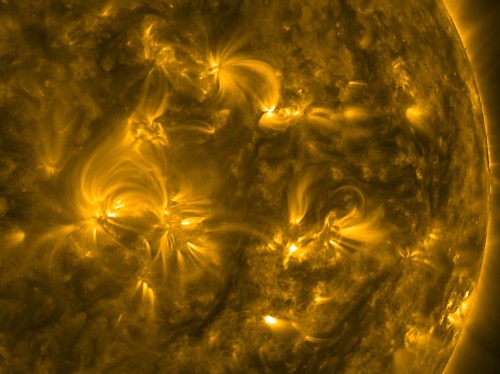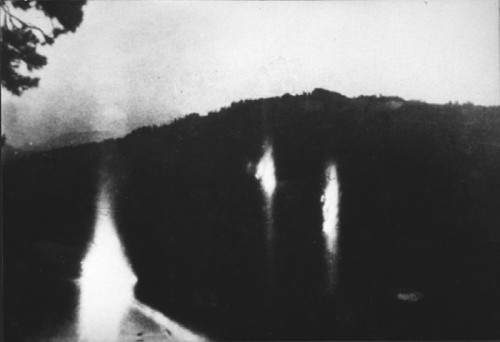Tag archives: earth sciences
Space weather: it’s all about impact
By Susan Curtis

Dangerous affair – an extreme ultraviolet image of a tangle of arched magnetic filed lines in the Sun’s corona, taken in January 2016 by NASA’s Solar Dynamics Observatory. (Courtesy: Solar Dynamics Observatory, NASA)
We all love a good disaster movie, but when it comes to real life it’s all too easy to downplay a dangerous but distant threat. Many people choose to live on active volcanoes, the citizens of San Francisco know that “the Big One” could strike at any moment, and yet they believe that the benefits of living in those locations outweigh the risk of a severe event happening in their lifetime.
The same dilemma faces the community of scientists, engineers and policy-makers who are working to understand the impacts of space weather – changes in the Earth’s environment that are largely are driven by physical processes originating from the Sun. Space weather has the potential to disrupt or even damage critical infrastructures on Earth, such as the power grids, aviation routes and communication systems that modern societies depend on, but the last notable event dates back to 2003.
That’s why Mike Hapgood, who heads up the Space Weather Group at RAL Space, part of the UK’s Rutherford Appleton Laboratory, has written a new, free-to-read Physics World Discovery ebook called Space Weather. “I thought it would be a great opportunity to highlight what space weather is really about, and to show how we are linking our scientific knowledge to a better understanding of the impacts on society,” he comments.
View all posts by this author | View this author's profile
Cracking the earthquake lights mystery and out-of-this-world technology

A photograph of streams of lights taken in 1977 near Brasov, Romania, about 100 km from the epicentre of a M 7.2 earthquake. (Courtesy: Seismological Society of America)
By Tushna Commissariat
In case you missed it, I was at the APS March meeting in Denver, Colorado last week and I was blogging about a whole host of interesting talks and sessions that I attended. Although I am back in Bristol now, there were one or two other talks that I thought covered some very interesting physics, so here’s a catch-up.
Slip slidin’ away
Seasoned physicsworld.com readers will remember that earlier this year, we featured a rather intriguing story on the phenomenon of earthquake lights – the mysterious and unpredictable glowing lights that seem to appear before some earthquakes. First documented in the 1600s and seen as recently as the Fukushima earthquake of 2011, the “unidentified glowing objects” add to the long list of possible earthquake precursors, and so are of interest. The study that we wrote about in January looked at 65 well-documented events of such lights and concluded that they may occur thanks to a particular type of geological fault – a subvertical fault – causing the earthquake.
Cruise-ship physics, the many ways to tie a tie, shaken-up carbon dating and more
By Tushna Commissariat
If you like piña coladas and quantum mechanics, then we hope you are currently on the two-week “Bright Horizons 19” Southeast Asia cruise, as on board is physicist and writer Sean Carroll. He will be giving multiple lectures over the next 15 days on everything from the Higgs boson to dark matter and other fundamentals of quantum mechanics. Also floating along with Carroll are other lecturers who will cover topics from natural history to genetics to military strategy. If, like us, you are stuck at home, you can take a look at Carroll’s slides on his blog, maybe have a cocktail while you are at it.
View all posts by this author | View this author's profile
Why do beer bottles foam when struck on top?

A foamy mess in the making. (Courtesy: Javier Rodríguez-Rodríguez)
By Hamish Johnston
We’ve all had a friend who does it – you’re deep in conversation at a party, beer bottle in hand, when someone sneaks up and taps the top of your bottle with theirs, causing a foamy mess to erupt from your bottle. And to add insult to injury, their bottle doesn’t foam.
Now, physicists in Spain and France have studied this curious effect and gained a better understanding of how it occurs. While their work won’t prevent wet shoes and slippery floors at university social gatherings, the researchers believe their work could provide insights into geological features such as oil reservoirs, mud volcanoes and “exploding lakes”.
Earth sciences: unlocking the secrets of a dynamic planet
By Joe McEntee, group editor at IOP Publishing
The latest video report from our globe-trotting multimedia team offers an “up close and personal” take from the bleeding edge of the Earth sciences, as told to us by faculty and graduate students in the geosciences department at the University of Texas at Dallas (UT Dallas).
Filmed in the spring as an add-on to our coverage of the American Physical Society March Meeting in Dallas, the interviews cover a lot of ground – to be expected for a discipline that aims to unlock the secrets of the solar system’s most active planet.
Carlos Aiken and colleagues, for example, are using an approach called cybermapping (which integrates laser scanning, digital photography and satellite positioning, among other sensors) to build 3D photorealistic models of surface geology around the world. Their work is being applied in oil exploration and education (for virtual field trips).
Meanwhile, fellow researcher John Ferguson is applying a technique called 4D microgravity – essentially ultraprecise gravitational measurements, a few parts per billion of the Earth’s gravitational field – to monitor the success (or otherwise) of CO2 sequestration in underground reservoirs.
Another important strand of the UT Dallas geosciences programme is the use of remote sensing (specifically, space geodetic satellite observation) to understand changes in Earth systems over time. “There’s much more to it [remote sensing] than pretty pictures,” explains Alexander Braun.
“You can actually measure real physical parameters – such as the [Earth’s] gravity field or magnetic field – and, more importantly, you can detect surface deformation. The Earth is a very active planet and it is crucial for us to understand when and where it is moving.”
In the second video (below), senior scientists in the UT Dallas geosciences programme explain what attracted them to a career in the Earth sciences. It seems if you like to travel and have a hankering for the outdoors then Earth sciences could be just the ticket.
Or, as Bob Stern puts it, “It’s really a remarkable opportunity to get out and see things that no-one else gets to see – that you would never see as a tourist.”
View all posts by this author | View this author's profile